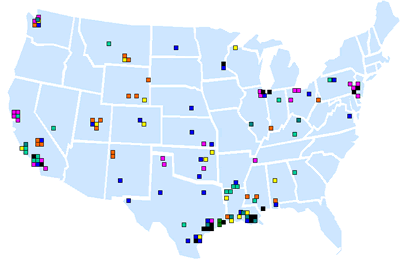Petroleum refineries are marvels of modern engineering. A maze of pipes, distillation columns, and chemical reactors turn crude oil into valuable products. The U.S. has over 150 refineries that can process anywhere between 5,000 and 500,000 barrels of oil a day. These refineries turn crude oil into the gasoline and chemical feedstocks that keep the country running. Refineries cost billions of dollars, employ several thousand workers and operate 365/24/7.
Petroleum refining has grown increasingly complex in the last 20 years. Lower-quality crude oil, crude oil price volatility, and environmental regulations that require cleaner manufacturing processes and higher-performance products present new challenges to the refining industry. Improving processes, and increasing the efficiency of energy use with technology research and development are key to meeting the challenges and maintaining the viability of the US petroleum refining industry.
Geography
The U.S. has 152 refineries operating in 32 states. These refineries employ more than 107,000 people. Refinery product consumption is ubiquitous, occurring throughout the USA. Nearly one million Americans are employed by more than 125,000 service stations across the nation, most of which are independently owned and operated.

Markets
Refining produces not only fuels but raw materials for the petrochemical industry (plastics, pharmaceuticals, agrochemicals, etc.). Crude oil is broken into various fractions. Modern refineries are able to alter the ratios of the different fractions to meet demand, and maximize profit. Demand varies seasonally and geographically. During the summer driving months, the public consumes vast amounts of gasoline, whereas during the winter more heating fuel oil is consumed. These demands also vary by geography depending upon whether you live in the frigid north, or the humid south.
| PRODUCT |
Gallons per barrel |
| gasoline |
19.5 |
| diesel & home heating oil |
9.2 |
| kerosene-type jet fuel |
4.1 |
| residual fuel oil |
2.3 |
| liquefied refinery gases |
1.9 |
| still gas |
1.9 |
| coke |
1.8 |
| asphalt and road oil |
1.3 |
| petrochemical feedstock |
1.2 |
| lubricants |
0.5 |
| kerosene |
0.2 |
| other |
0.3 |
Average yields for U.S. refineries 1995 -- A 42 gallon barrel of crude oil yields 44.2 gallons of product "processing gain"
Production
The U.S. is the largest, most sophisticated producer of refined petroleum products the world, with 16.5 million barrels per day of crude distillation capacity.
Energy
Petroleum refining is unique among manufacturing industries from an energy standpoint. It is the country's single largest source of energy products, supplying 40 percent of total U.S. energy demand and 99 percent of transportation fuels. At the same time, it is also the largest industrial consumer, representing about 7 percent of total U.S. energy consumption.
Energy & Environmental Profile (PDF 2.56 MB) Download Acrobat Reader
This informative report provides an overview of the U.S. Petroleum Refining Industry including data on market trends, energy and material consumption, and an environmental overview.
Industry Analysis in Brief
OIT, in partnership with the Energy Information Administration, has created a comprehensive report that captures information on the economics, energy use, technologies and management activities that affect the Petroleum Refining industry.
|

